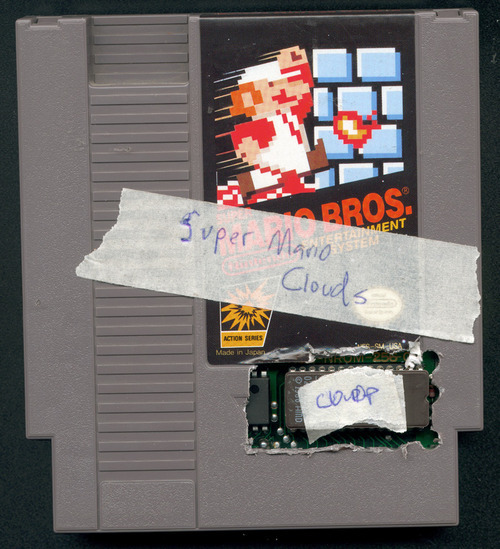
Technologies: ART EEPROM burner, DASM 6502 BSD, data projectors, NBASIC BSD, Nintendo Entertainment System, RockNES, Super Mario Brothers Nintendo cartridge, video distributor
Current URL: http://www.coryarcangel.com/things-i-made/SuperMarioClouds
Wikibook Chapter: https://wiki.brown.edu/confluence/display/MarkTribe/Cory+Arcangel
Not a web-based art form, but yet a compelling example of hacking a console game, Super Mario Clouds presents an example of creation by deletion.
It’s just clouds scrolling by, WTF? But check out what Cory Archangel did to make it
To make Super Mario Clouds, Arcangel hacked Super Mario Brothers, a classic video game that made its debut in 1985. He replaced the program chip from an old Nintendo Entertainment System game cartridge with a new chip that he programmed himself (by borrowing code he found on computer hobby scene Web sites) to erase everything in the original game except the clouds.
Just look at the jagged cuts to get to the chip, and the masking tape labels!

I cannot speak much to the artistic references in the book chapter:
Arcangel’s process of visual subtraction evokes Robert Rauschenberg’s Erased de Kooning Drawing (1953), in which the artist famously erased a composition by Willem de Kooning to create a new work of art. Super Mario Clouds suggests a similar sensibility, simultaneously conveying a stripped-down aesthetic and a rebellious, bad-boy attitude that challenges conventional notions of artistic integrity and authenticity.
but the notion of creation by deletion is intriguing for the way it runs 180 degrees to our assumption of what creativity means- making stuff, right? But look at Austin Kleon’s Blackout Poetry– its not just haphazard erasing to make a poem from existing works by erasing portions (maybe easier than hacking a NIntendo cartridge).
While many new media artists fetishize emerging technologies, Arcangel eschews the graphic realism of contemporary game titles like Grand Theft Auto, celebrating instead the crude “dirt style” imagery of early video games
The same might be said today about the environment of Minecraft (which spawns in the world and derivatives elsewhere).
Cory Arcangel provides a detailed illustrated guide to his hack — like
The first thing you will need to get is an original Super Mario Brothers cartridge. Not a “Duck Hunt+Mario Brothers” cartridge, but just a plain old Super Mario Brothers cartridge. Next you should unscrew the plastic back on the cartridge, and inside you will see a circuit board like the one you see below. There are two chips on this board. The CHR chip, and the PRG chip. We are interested in the PRG chip for this project. Also please make sure the cartridge says NES-NROM-01 (01-05 in also fine). This let`s us know it is a 32k Nintendo circut board.
And in a modern spirt, also shares via github the code he used to modify the game.
Even more timely or i time, in reference to the GIF above:
when I originally posted this on the Internet in 02, the web wasn’t actually able to contain video (it sounds funny now, but remember youtube didn’t start making waves till like 05ish??), therefore I made a gif of the video. Of the gazillion bootlegs of this project, most are from this gif.
What’s a video game without the character, action, and scenery? Dreamy?


